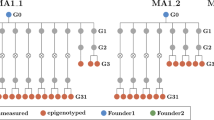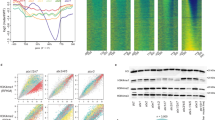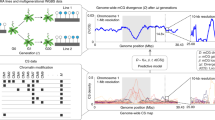Abstract
Cytosine methylation, a common form of DNA modification that antagonizes transcription, is found at transposons and repeats in vertebrates, plants and fungi. Here we have mapped DNA methylation in the entire Arabidopsis thaliana genome at high resolution. DNA methylation covers transposons and is present within a large fraction of A. thaliana genes. Methylation within genes is conspicuously biased away from gene ends, suggesting a dependence on RNA polymerase transit. Genic methylation is strongly influenced by transcription: moderately transcribed genes are most likely to be methylated, whereas genes at either extreme are least likely. In turn, transcription is influenced by methylation: short methylated genes are poorly expressed, and loss of methylation in the body of a gene leads to enhanced transcription. Our results indicate that genic transcription and DNA methylation are closely interwoven processes.
This is a preview of subscription content, access via your institution
Access options
Subscribe to this journal
Receive 12 print issues and online access
$209.00 per year
only $17.42 per issue
Buy this article
- Purchase on Springer Link
- Instant access to full article PDF
Prices may be subject to local taxes which are calculated during checkout








Similar content being viewed by others
Accession codes
References
Chan, S.W., Henderson, I.R. & Jacobsen, S.E. Gardening the genome: DNA methylation in Arabidopsis thaliana. Nat. Rev. Genet. 6, 351–360 (2005).
Freitag, M. & Selker, E.U. Controlling DNA methylation: many roads to one modification. Curr. Opin. Genet. Dev. 15, 191–199 (2005).
Goll, M.G. & Bestor, T.H. Eukaryotic cytosine methyltransferases. Annu. Rev. Biochem. 74, 481–514 (2005).
Klose, R.J. & Bird, A.P. Genomic DNA methylation: the mark and its mediators. Trends Biochem. Sci. 31, 89–97 (2006).
Kakutani, T., Kato, M., Kinoshita, T. & Miura, A. Control of development and transposon movement by DNA methylation in Arabidopsis thaliana. Cold Spring Harb. Symp. Quant. Biol. 69, 139–143 (2004).
Kato, M., Miura, A., Bender, J., Jacobsen, S.E. & Kakutani, T. Role of CG and non-CG methylation in immobilization of transposons in Arabidopsis. Curr. Biol. 13, 421–426 (2003).
Selker, E.U. Genome defense and DNA methylation in Neurospora. Cold Spring Harb. Symp. Quant. Biol. 69, 119–124 (2004).
Singer, T., Yordan, C. & Martienssen, R.A. Robertson' Mutator transposons in A. thaliana are regulated by the chromatin-remodeling gene decrease in DNA methylation (DDM1). Genes Dev. 15, 591–602 (2001).
Bestor, T.H. DNA methylation: evolution of a bacterial immune function into a regulator of gene expression and genome structure in higher eukaryotes. Phil. Trans. R. Soc. Lond. B 326, 179–187 (1990).
Bird, A.P. Gene number, noise reduction and biological complexity. Trends Genet. 11, 94–100 (1995).
Field, L.M., Lyko, F., Mandrioli, M. & Prantera, G. DNA methylation in insects. Insect Mol. Biol. 13, 109–115 (2004).
Simmen, M.W. et al. Nonmethylated transposable elements and methylated genes in a chordate genome. Science 283, 1164–1167 (1999).
Tran, R.K. et al. DNA methylation profiling identifies CG methylation clusters in Arabidopsis genes. Curr. Biol. 15, 154–159 (2005).
Xiao, W. et al. Imprinting of the MEA Polycomb gene is controlled by antagonism between MET1 methyltransferase and DME glycosylase. Dev. Cell 5, 891–901 (2003).
Weber, M. et al. Chromosome-wide and promoter-specific analyses identify sites of differential DNA methylation in normal and transformed human cells. Nat. Genet. 37, 853–862 (2005).
Jurka, J. et al. Repbase Update, a database of eukaryotic repetitive elements. Cytogenet. Genome Res. 110, 462–467 (2005).
Kato, M., Takashima, K. & Kakutani, T. Epigenetic control of CACTA transposon mobility in Arabidopsis thaliana. Genetics 168, 961–969 (2004).
Berardini, T.Z. et al. Functional annotation of the Arabidopsis genome using controlled vocabularies. Plant Physiol. 135, 745–755 (2004).
Lippman, Z. et al. Role of transposable elements in heterochromatin and epigenetic control. Nature 430, 471–476 (2004).
Tran, R.K. et al. Chromatin and siRNA pathways cooperate to maintain DNA methylation of small transposable elements in Arabidopsis. Genome Biol. 6, R90 (2005).
Zilberman, D. & Henikoff, S. Silencing of transposons in plant genomes: kick them when they're down. Genome Biol. 5, 249 (2004).
Soppe, W.J. et al. The late flowering phenotype of fwa mutants is caused by gain-of-function epigenetic alleles of a homeodomain gene. Mol. Cell 6, 791–802 (2000).
Kinoshita, T. et al. One-way control of FWA imprinting in Arabidopsis endosperm by DNA methylation. Science 303, 521–523 (2004).
Jullien, P.E., Kinoshita, T., Ohad, N. & Berger, F. Maintenance of DNA methylation during the Arabidopsis life cycle is essential for parental imprinting. Plant Cell 18, 1360–1372 (2006).
Gehring, M. et al. DEMETER DNA glycosylase establishes MEDEA polycomb gene self-imprinting by allele-specific demethylation. Cell 124, 495–506 (2006).
Schmid, M. et al. A gene expression map of Arabidopsis thaliana development. Nat. Genet. 37, 501–506 (2005).
Zhang, X. et al. Genome-wide high-resolution mapping and functional analysis of DNA methylation in Arabidopsis. Cell 126, 1189–1201 (2006).
Gilfillan, G.D. et al. Chromosome-wide gene-specific targeting of the Drosophila dosage compensation complex. Genes Dev. 20, 858–870 (2006).
Barry, C., Faugeron, G. & Rossignol, J.L. Methylation induced premeiotically in Ascobolus: coextension with DNA repeat lengths and effect on transcript elongation. Proc. Natl. Acad. Sci. USA 90, 4557–4561 (1993).
Rountree, M.R. & Selker, E.U. DNA methylation inhibits elongation but not initiation of transcription in Neurospora crassa. Genes Dev. 11, 2383–2395 (1997).
Hohn, T., Corsten, S., Rieke, S., Muller, M. & Rothnie, H. Methylation of coding region alone inhibits gene expression in plant protoplasts. Proc. Natl. Acad. Sci. USA 93, 8334–8339 (1996).
Lorincz, M.C., Dickerson, D.R., Schmitt, M. & Groudine, M. Intragenic DNA methylation alters chromatin structure and elongation efficiency in mammalian cells. Nat. Struct. Mol. Biol. 11, 1068–1075 (2004).
Belotserkovskaya, R., Saunders, A., Lis, J.T. & Reinberg, D. Transcription through chromatin: understanding a complex FACT. Biochim. Biophys. Acta 1677, 87–99 (2004).
Kaplan, C.D., Laprade, L. & Winston, F. Transcription elongation factors repress transcription initiation from cryptic sites. Science 301, 1096–1099 (2003).
Mason, P.B. & Struhl, K. The FACT complex travels with elongating RNA polymerase II and is important for the fidelity of transcriptional initiation in vivo. Mol. Cell. Biol. 23, 8323–8333 (2003).
Schwabish, M.A. & Struhl, K. Asf1 mediates histone eviction and deposition during elongation by RNA polymerase II. Mol. Cell 22, 415–422 (2006).
Johnson, L., Cao, X. & Jacobsen, S. Interplay between two epigenetic marks. DNA methylation and histone H3 lysine 9 methylation. Curr. Biol. 12, 1360–1367 (2002).
Svejstrup, J.Q. Transcription: histones face the FACT. Science 301, 1053–1055 (2003).
Thibaud-Nissen, F. et al. Development of Arabidopsis whole-genome microarrays and their application to the discovery of binding sites for the TGA2 transcription factor in salicylic acid-treated plants. Plant J. 47, 152–162 (2006).
Liu, C.L., Schreiber, S.L. & Bernstein, B.E. Development and validation of a T7 based linear amplification for genomic DNA. BMC Genomics 4, 19 (2003).
Jacobsen, S.E., Sakai, H., Finnegan, E.J., Cao, X. & Meyerowitz, E.M. Ectopic hypermethylation of flower-specific genes in Arabidopsis. Curr. Biol. 10, 179–186 (2000).
Acknowledgements
We thank J. Penterman (University of California Berkeley) for providing genomic DNA, R.L. Fischer (University of California Berkeley) for met1-6 seeds, M.E. Figueroa and J. Greally for help with the linear amplification protocol, T.D. Bryson for technical assistance and P. Talbert for comments on the manuscript. D.Z. is a Leukemia and Lymphoma Society Fellow. M.G. is a Howard Hughes Medical Institute Fellow of the Life Sciences Research Foundation.
Author information
Authors and Affiliations
Contributions
This study was designed by D.Z. and S.H.; D.Z., M.G. and R.K.T. performed the experiments; D.Z., T.B. and S.H. analyzed the data and D.Z. and S.H. wrote the paper.
Corresponding author
Ethics declarations
Competing interests
The authors declare no competing financial interests.
Supplementary information
Supplementary Fig. 1
Bisulfite sequencing analysis of Arabidopsis genes. (PDF 274 kb)
Supplementary Fig. 2
Functional annotation of methylated and unmethylated genes. (PDF 437 kb)
Supplementary Fig. 3
Box plots of genic methylation. (PDF 406 kb)
Supplementary Fig. 4
Relationship between DNA methylation and expression in Arabidopsis. (PDF 1189 kb)
Supplementary Table 1
Bisulfite sequencing data, methylated vs. unmethylated gene calls and correlation between methylation in wild-type and expression in met1-6. (XLS 1352 kb)
Supplementary Table 2
Average transcription levels and lengths of genes in functional categories. (PDF 12 kb)
Supplementary Table 3
Methylated genes are preferentially targeted by siRNAs. (PDF 8 kb)
Rights and permissions
About this article
Cite this article
Zilberman, D., Gehring, M., Tran, R. et al. Genome-wide analysis of Arabidopsis thaliana DNA methylation uncovers an interdependence between methylation and transcription. Nat Genet 39, 61–69 (2007). https://doi.org/10.1038/ng1929
Received:
Accepted:
Published:
Issue Date:
DOI: https://doi.org/10.1038/ng1929
This article is cited by
-
Comparative epigenetic and genetic spatial structure in Mediterranean mountain plants: a multispecies study
Heredity (2024)
-
Epigenetics: Toward improving crop disease resistance and agronomic characteristics
Plant Biotechnology Reports (2024)
-
DNA methylome analysis provides insights into gene regulatory mechanism for better performance of rice under fluctuating environmental conditions: epigenomics of adaptive plasticity
Planta (2024)
-
Dynamic DNA methylation turnover in gene bodies is associated with enhanced gene expression plasticity in plants
Genome Biology (2023)
-
An epi-allele of SMS causes Sanming dominant genic male sterility in rice
Science China Life Sciences (2023)



